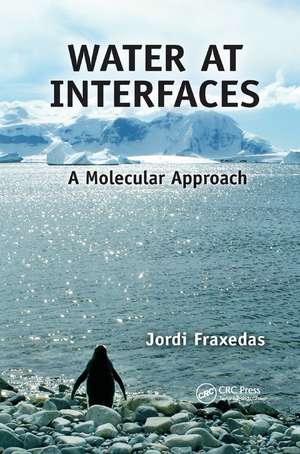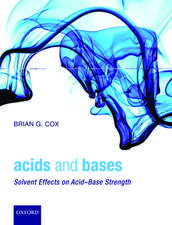Water at Interfaces: A Molecular Approach
Autor Jordi Fraxedasen Limba Engleză Paperback – 12 iun 2019
The text explores the main interfaces involving pure and ion-free condensed (liquid and solid) water, including water vapor/liquid water, liquid/oil, and liquid/solid interfaces. It examines water molecules on ideal surfaces—well-ordered (crystalline) and defect-free—covering topics such as electronic structure using frontier orbitals and substrate-induced structuring. The book discusses the affinity of water to surfaces, hydrophobicity and hydrophilicity, emphasizing two extreme cases of affinity. It then addresses real solid surfaces where water/solid interfaces play a key role in actual working conditions, examining water purification, photocatalytic activity, corrosion and degradation, and atmospheric agents.
The final chapter deals with the interaction of water with the heterogeneous and complex surfaces of biomolecules, which can both influence the structure of the surrounding water and be modulated by the surrounding liquid. The author discusses simple to more complex biomolecules from peptides to proteins, nucleic acids, and membranes.
| Toate formatele și edițiile | Preț | Express |
|---|---|---|
| Paperback (1) | 353.46 lei 6-8 săpt. | |
| CRC Press – 12 iun 2019 | 353.46 lei 6-8 săpt. | |
| Hardback (1) | 987.72 lei 6-8 săpt. | |
| CRC Press – 15 apr 2014 | 987.72 lei 6-8 săpt. |
Preț: 353.46 lei
Preț vechi: 477.51 lei
-26% Nou
Puncte Express: 530
Preț estimativ în valută:
67.64€ • 72.32$ • 56.39£
67.64€ • 72.32$ • 56.39£
Carte tipărită la comandă
Livrare economică 17 aprilie-01 mai
Preluare comenzi: 021 569.72.76
Specificații
ISBN-13: 9781138374508
ISBN-10: 1138374504
Pagini: 258
Ilustrații: 109
Dimensiuni: 156 x 234 mm
Greutate: 0.48 kg
Ediția:1
Editura: CRC Press
Colecția CRC Press
ISBN-10: 1138374504
Pagini: 258
Ilustrații: 109
Dimensiuni: 156 x 234 mm
Greutate: 0.48 kg
Ediția:1
Editura: CRC Press
Colecția CRC Press
Cuprins
An Introduction to Water. Interfaces of Condensed Pure Water. Water on Ideal Solid Surfaces. Hydrophobicity and Hydrophilicity. Water on Real Solid Surfaces. Water/Biomolecule Interfaces. Appendix A Buoyancy and Surface Tension. Appendix B Capillary Forces. Appendix C Marangoni–Bénard Patterns. Index.
Notă biografică
Jordi Fraxedas obtained his Ph.D. from the University of Stuttgart, Germany. His thesis work was performed at the Max Planck Institute for Solid State Research under the supervision of Prof. M. Cardona. After a post-doctoral position at the European Synchrotron Radiation Facility in Grenoble (France) and an established researcher position at the European Laboratory for Particle Physics (CERN) in Geneva (Switzerland), he joined the Solid State Research Institute of Barcelona of the Spanish Research Council in 1995. He is now leading the Force Probe Microscopy and Surface Nanoengineering Group at the Catalan Institute of Nanoscience and Nanotechnology in Bellaterra (Barcelona). His research activity is focused on interfacial phenomena arising from the nanostructuration of surfaces and from the interaction of molecules with surfaces. He has co-authored more than 100 peer-reviewed scientific articles and published the book entitled Molecular Organic Materials: From Molecules to Crystalline Solids (Cambridge University Press, 2006).
Descriere
This book provides a broad, multidisciplinary introduction to water at interfaces, focusing on its molecular nature. It is written for practicing scientists and engineers who want a fundamental understanding of what water does at surfaces and interfaces. It covers a host of examples to convey general principles, including the hydrophobicity and hydrophilicity of materials, the special structure of interfacial water for biological and electrochemical processes, the role of water at biosurfaces (DNA, proteins, and membranes), friction and adhesion, marine aerosols, ice formation, wetting-dewetting, and filtration.










